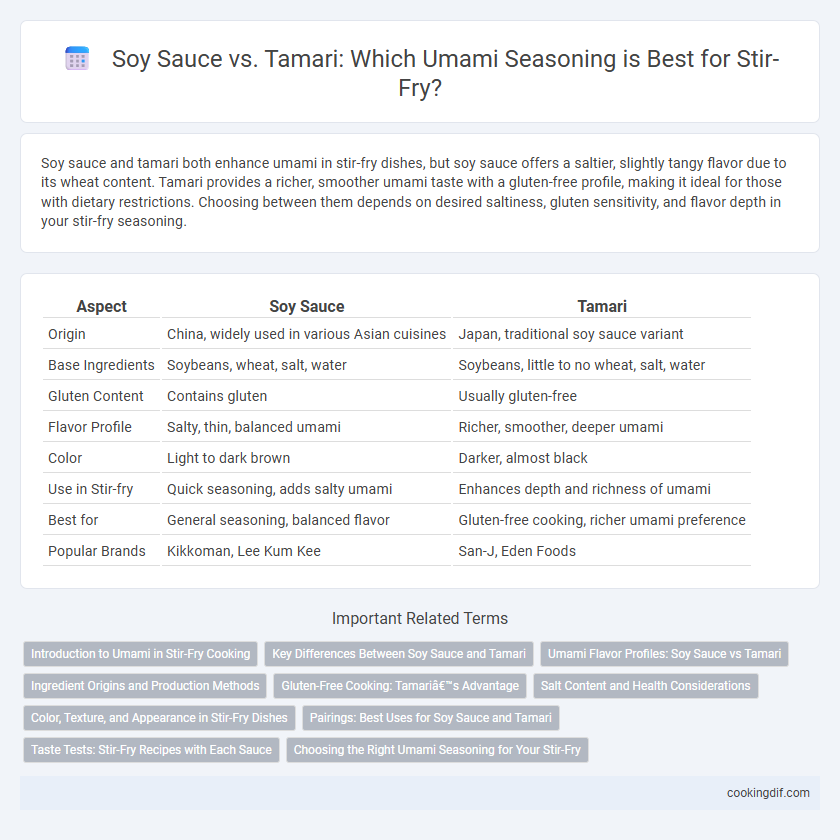Soy sauce and tamari both enhance umami in stir-fry dishes, but soy sauce offers a saltier, slightly tangy flavor due to its wheat content. Tamari provides a richer, smoother umami taste with a gluten-free profile, making it ideal for those with dietary restrictions. Choosing between them depends on desired saltiness, gluten sensitivity, and flavor depth in your stir-fry seasoning.
Table of Comparison
| Aspect | Soy Sauce | Tamari |
|---|---|---|
| Origin | China, widely used in various Asian cuisines | Japan, traditional soy sauce variant |
| Base Ingredients | Soybeans, wheat, salt, water | Soybeans, little to no wheat, salt, water |
| Gluten Content | Contains gluten | Usually gluten-free |
| Flavor Profile | Salty, thin, balanced umami | Richer, smoother, deeper umami |
| Color | Light to dark brown | Darker, almost black |
| Use in Stir-fry | Quick seasoning, adds salty umami | Enhances depth and richness of umami |
| Best for | General seasoning, balanced flavor | Gluten-free cooking, richer umami preference |
| Popular Brands | Kikkoman, Lee Kum Kee | San-J, Eden Foods |
Introduction to Umami in Stir-Fry Cooking
Soy sauce and tamari are both essential for adding umami depth to stir-fry dishes, with soy sauce offering a balanced saltiness and tamari providing a richer, gluten-free alternative. Umami, the savory flavor profile derived from glutamates, enhances the complexity and mouthwatering quality of vegetables, meats, and sauces in stir-frying. Choosing between soy sauce and tamari depends on dietary preferences and desired intensity of umami flavor in Asian-inspired cooking.
Key Differences Between Soy Sauce and Tamari
Soy sauce typically contains wheat, resulting in a thinner consistency and a slightly sweeter, saltier flavor, while tamari is usually wheat-free with a richer, smoother taste that enhances umami in stir-fry dishes. Tamari's higher protein content and less salty profile offer a deeper, more balanced umami, making it ideal for gluten-free recipes. The distinct brewing processes contribute to tamari's robust aroma and soy sauce's brighter sheen, influencing the overall seasoning intensity in stir-fry cooking.
Umami Flavor Profiles: Soy Sauce vs Tamari
Soy sauce and tamari both deliver rich umami flavor but differ in taste intensity and salt content, with soy sauce offering a sharper, saltier profile ideal for bold stir-fry seasonings. Tamari, often wheat-free, provides a smoother and more mellow umami experience, enhancing dishes with subtle depth without overpowering other ingredients. Choosing between the two depends on dietary preferences and desired flavor balance, with tamari favored for gluten-free diets and a less salty umami impact.
Ingredient Origins and Production Methods
Soy sauce, originating from China over 2,500 years ago, is traditionally made by fermenting soybeans, roasted wheat, salt, and water with mold cultures like Aspergillus oryzae. Tamari, a Japanese variation, is primarily brewed from soybeans with little to no wheat, resulting in a thicker, less salty condiment due to its unique fermentation process. The differing ingredient ratios and fermentation techniques influence their umami intensity and flavor profiles, making tamari a preferred gluten-free alternative with a richer soy essence for stir-fry dishes.
Gluten-Free Cooking: Tamari’s Advantage
Tamari offers a superior gluten-free option for enhancing umami flavor in stir-fry dishes compared to traditional soy sauce, which often contains wheat. Made primarily from fermented soybeans with little to no wheat, tamari provides a richer, smoother taste without compromising dietary restrictions. Its use ensures robust, savory depth in gluten-free stir-fries, making it ideal for those seeking authentic taste alongside allergen-friendly cooking.
Salt Content and Health Considerations
Soy sauce typically contains higher sodium levels compared to tamari, making it a more potent source of salt in stir-fry dishes. Tamari, often gluten-free, provides a rich umami flavor with less salt, appealing to those seeking lower sodium intake or gluten sensitivity. Selecting tamari can enhance health considerations without compromising the savory depth essential for authentic stir-fry seasoning.
Color, Texture, and Appearance in Stir-Fry Dishes
Soy sauce imparts a rich, dark brown color and a slightly thin texture that evenly coats stir-fry ingredients, enhancing their glossy appearance. Tamari, usually thicker and darker with a smoother consistency, provides a deeper umami flavor and a more pronounced sheen on vegetables and meats. The choice between soy sauce and tamari affects not only the visual appeal but also the mouthfeel of the finished stir-fry dish.
Pairings: Best Uses for Soy Sauce and Tamari
Soy sauce, with its balanced salty and slightly sweet flavor, pairs excellently with stir-fried vegetables, chicken, and beef, enhancing traditional Asian recipes like chow mein and teriyaki. Tamari, a gluten-free alternative with a richer, smoother umami profile, complements delicate ingredients such as tofu, mushrooms, and seafood, making it ideal for gluten-sensitive diets or refined Asian dishes. Both soy sauce and tamari effectively boost umami, but choosing between them depends on dietary needs and the desired flavor intensity in stir-fry seasoning.
Taste Tests: Stir-Fry Recipes with Each Sauce
Soy sauce delivers a sharp, salty umami that enriches stir-fry dishes with traditional depth and a slight tang. Tamari offers a smoother, less salty profile with a richer, mellow umami flavor, especially favored in gluten-free cooking. Taste tests reveal tamari enhances the natural sweetness of vegetables, while soy sauce provides a bolder, more pronounced umami that highlights meat and tofu textures.
Choosing the Right Umami Seasoning for Your Stir-Fry
Soy sauce and tamari both bring rich umami flavors to stir-fry dishes, but tamari offers a gluten-free option with a smoother, less salty taste compared to traditional soy sauce. Soy sauce contains wheat and has a sharper, saltier profile that enhances marinades and quick-cooked vegetables more intensely. Selecting tamari or soy sauce depends on dietary restrictions and flavor preferences to achieve the perfect umami balance in your stir-fry.
Soy sauce vs tamari for umami seasoning Infographic

 cookingdif.com
cookingdif.com